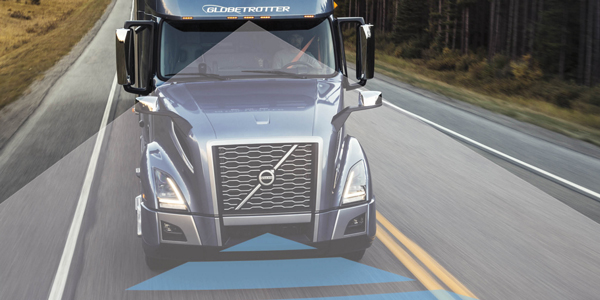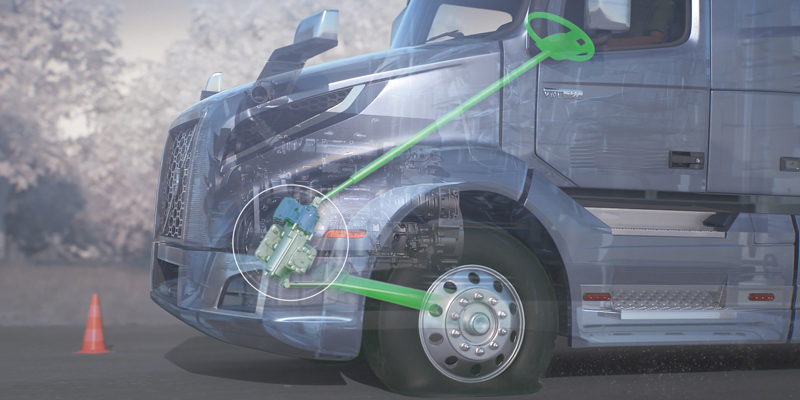The second generation of Volvo’s advanced driver assistance system, Volvo Active Driver Assist (VADA), is about to roll out onto the road. The system was announced earlier this year and went into production Sept. 9.
We know that the details surrounding advanced safety systems can get confusing. So here’s an FAQ that, with the help of some of Volvo’s product experts, goes over the basics and the details surrounding VADA 2.0.
Q: What are the basics of the system?
VADA was developed in partnership with Bendix; it is based on the Bendix Wingman Fusion system, but with some Volvo-specific tweaks.
The system uses camera and radar sensors that detect motorized vehicles within the vehicle’s proximity. The technology enables a series of features to activate driver alerts and foundation braking according to information detected by these advanced sensors.

Q: Let’s talk about those features. What’s new in version 2.0?
The system is now standard. VADA 2.0 is now standard on all new Volvo trucks (the VNR, VNL and VNX), starting with the upcoming 2021 model year.
Improved Automatic Emergency Braking. Automatic Emergency Braking (AEB) is a feature that uses camera and radar sensors to determine how traffic is behaving around the truck. When a vehicle is detected, audible and visual warnings alert the driver to take action. If the driver does not respond, AEB engages to mitigate potential collisions. The main improvement made to this feature, which alerts the driver with audible and visual alerts up to 3.5 seconds before a potential impact, is that a full stop is now possible from a speed of 50 MPH (it was 35 MPH in the 1.0 version of the system).
Front air disc brakes are now standard. This and the improved stopping distance mentioned above go hand in hand. That 50 MPH number is only available if the truck has air disc brakes.
If you still want drum brakes on the truck, Ash Makki, product marketing manager for technology with Volvo Trucks North America, answers: “To get the 50 MPH reduction, disc brakes are a must-have. If you’re getting drum brakes, you are still going to get an improved stopping distance than the 35 MPH on the current system. It’s going to fall into the 40 MPH range. But to get the full capacity, we strongly recommend the disc brakes for better stopping distance. That’s why we’re pushing disc brakes as a standard feature.”
Adaptive Cruise Control (ACC) has added the Cruise Auto Resume feature. This feature enables the truck to revert back to cruising speed with Cruise Auto Resume (also known as “Slow & Go”) at speeds above 10 MPH—an improved number as of this incarnation of VADA.
Driver Awareness Support offers an in-cab, windshield- mounted camera with data capture support. The purpose of this, Volvo says, is to enhance driver coaching and data availability.
Highway Departure Warning. This is an upgrade over the Lane Departure Warning on the previous incarnation of the system. So what’s different about it?
“With lane departure warning, the camera would detect dotted or solid lines. If the truck left the lane, the driver would get an alert if the truck was going above 37 MPH,” explains Allison Athey, product marketing manager with Volvo Trucks North America. “The highway departure warning is a second level to that. So if the truck leaves the highway, you need the solid line on one side or the other. First the driver will get the lane departure warning and then if the driver does not react, the driver get another warning, and the second warning is more obvious visually and it’s louder as well and with a different message: ‘highway departure imminent.’”
This will go activate anytime the driver leaves the highway without putting on a turn signal—yet another incentive to use those.
Additionally, there is no lag when changing lanes.
“Let’s say a vehicle in front of the truck slows down, out of the blue for no reason,” Makki begins. “That’s automatically going to trigger automatic emergency braking within the truck, causing it to start slowing down. The normal driver reaction is that he wants to get into the adjacent lane. In the previous system, once the truck had moved to the next lane, the automatic emergency braking process would disengage. Then it would re-engage after calculating the distance to the vehicle ahead of it in the new lane. That’s a time lag that could cause the truck to speed up and get too close to that vehicle.
Lightning round! More FAQs on VADA 2.0:
Q: How does the system prioritize these alerts?
Automatic Emergency Braking (AEB) will take priority over all other features, Makki notes. If the truck is leaving the highway and the system detects a car on the shoulder, the AEB will calculate the distance and will prepare to stop if the driver does not take action.
Note that the highway lane departure warning will not go off because the system has sensed that a more important alert is needed.
“Front collision avoidance will always be the first priority of the system,” Makki stresses.
Q: What features are optional on the system?
While outward-facing cameras are standard for VADA 2.0, driver-facing cameras are an option.
Optional features that will be released later in 2020 include a Traffic Stop & Driver Go feature for the Adaptive Cruise Control and standalone data capture options without the need for Lane Departure Warning.
Q: Are driver training resources available?
“We have a variety of training resources, including our Volvo Academy, that can go out and help the dealers. The dealers can provide the training,” Allison Athey, product marketing manager with Volvo Trucks North America, answers. “We have a variety of videos and lots of in-depth information available online. And, of course, the information is in the manual as well.”
Q: Can you deactivate the system if the need arises?
Only individual features can be deactivated. “For example,” Athey explains, “in a construction zone, we offer a lane departure warning deactivation switch that would deactivate that specific feature specifically for 10 minutes.”
But, Athey notes, you cannot deactivate the entire system—only this specific feature.

Q: Here’s the big question—what’s the payback on this system?
According to Volvo’s data, fleets who spec VADA 2.0 can save 25.3% per truck per year on collision-related costs—equivalent to a little more than $5,000 per truck.
Where does this data come from? Volvo based it on NHTSA data that shows that frontal collisions make up 31% of truck-related accidents. VADA 2.0, Volvo says, can reduce the number of frontal collisions by 82%.













